Samsung Galaxy Tab Pro 8.4 and 10.1 Review
by Jarred Walton on March 22, 2014 9:30 PM ESTSamsung Galaxy Pro Software
We’ve discussed TouchWiz UI extensively in the past, so I’m not going to rehash that here. Some people like it, others like me are mostly ambivalent, and still others seem to really dislike it. Besides the enhancement to the UI, Samsung has some other additions. Let’s quickly cover some of these here.
One of the biggest changes for me is the keyboard, and this is one of those items that I’m actually very happy using. I don’t like typing a lot on tablets, but Samsung’s addition of a dedicated row of number keys – basically emulating a regular keyboard – makes it that much less painful to do certain tasks (like entering passwords with numbers, letters, and symbols). The first time it appeared, I was a little confused as the keyboard looked quite a bit different than what I’m used to seeing, but after that initial surprise I found myself liking the keyboard more and more. Some people prefer Swype, or the regular Android keyboard, and that’s fine – if you know enough to prefer a different keyboard, you can always install one. The Samsung keyboard does support swiping as well as audio feedback; the Pro 10.1 also offers haptic feedback (vibration) on keyboard input, but I didn’t find that necessary.
Interestingly, since I just discussed the keyboard aspect, Samsung has their own custom gesture to capture a screenshot – the standard “Volume Up + Power” shortcut doesn’t work. To capture a screen, you swipe the side of your palm left to right or right to left across the screen. The only problem? It doesn’t always work properly, or at least I don’t think it works if the keyboard is active, hence the above photos of the keyboard rather than screen grabs. Personally, I’d prefer something less obtuse or difficult – how about just a long press of the task switcher or back button to take a screen shot? But I digress….
Moving on in the software coverage, probably the biggest addition here is the new Magazine UX. I wasn’t sure about it at first, but man you could waste a lot of time in there. There are tiles for News, Sports, Science and Technology, Arts and Culture, Photos and Design, Business, New and Noteworthy, and Style – and that’s it; you can’t add more than those eight categories, but you can disable some of them. You can also customize what each of those panes shows with all sorts of additional feeds (no, AnandTech isn’t in the Science and Technology section – boo!), and once enabled all you have to do is click on the tile to be presented with a “magazine”. Technically all of this appears to be using a piece of software called Flipboard, and Magazine UX is just the integration into the home screens of Android as far as I can tell – task switcher even labels the app as “Flipboard”. The biggest gripe people are going to have with Magazine UX is that it can’t be disabled – you will always have at least one Magazine UX screen in addition to the home screen (and you can make Magazine UX into your default screen if you prefer); end of discussion.
Another additional piece of software is Hancom Office, which allows you to run the typical office applications. You get a word processor, spreadsheet, presentations program (Hword, Hcell, and Hshow), and yes, they can open MS Office files – or at least the Office 2010 files I tried worked okay. Editing office files on a tablet isn’t something I’ve really tried to do, but even the ability to view them can be very useful. There are other free office apps out there, but Hancom looks fine from what I can see, and it’s normally a $17.77 purchase. You do need to create a Samsung account to access Hancom, apparently, but that was easy enough to do.
There’s at least one truly interesting feature with the latest TouchWiz UI on the Galaxy Pro line of tablets that is perhaps a sign of things to come. While Microsoft is busily moving us more towards a one screen, one app world with their Modern UI (okay, with the ability to do split-screen as well), Samsung has added multi-window mode on the Galaxy Pro tablets. It’s a bit raw right now, and it only supports certain applications, but you can actually have three (on the 8.4 and 10.1) or four windows (on the 12.2) open and resized at once. The window contents basically end up being stretched to fit, however, so you can get some weird warping if you don’t maintain the aspect ratio. When you minimize a window, it becomes a circular button that you can move around, and click on it to restore it to an active window.
An alternative that proves a bit more useful is the split-screen mode. Apparently the 12.2 can support four tiled apps (restricted to the support apps list), while the 8.4 and 10.1 only support split-screen, but you could open a browser in the bottom window and a video in the top, or two browsers, or some other combination. I tested the multi-window and split-screen modes with the web browser, video player, office, gallery, and Hang Outs (not all at once). It all worked as advertised, but there’s a limited amount of resizing available and clearly most apps aren’t really designed for this sort of operation. Maybe in a future version of Android we’ll see additional multi-tasking/multi-windowing features, but Samsung is at least playing around with the idea right now.
There are two more pieces of software that I didn’t have a chance to try out yet, E-Meeting and Remote PC. E-Meeting allows you to share a file (or files?) locally, with everyone on the same WiFi network. They can then join the meeting and see your presentation, spreadsheet, pictures, etc. on their own tablet. It’s basically the inverse of a projector, where instead of everyone seeing one screen you’re all given individual screen to look at. There’s also an integrated White Board for people to use for notes and such. Remote PC is a way to remotely access your Windows or OS X PC via your Samsung Pro tablet, through your Samsung account. You can copy files from your PC to your tablet (and I’d assume the reverse as well), or just remotely control your PC via the tablet. I’m not sure if Samsung is working with a third party (i.e. LogMeIn or Teamviewer), but similar functionality is available on Android devices in general with the right software.
There are plenty of other items I could discuss with the software and features, but let’s just wrap this up for now with one last feature: Smart screen (as I don’t think we’ve covered this previously). Smart screen uses the front-facing camera with face/eye recognition and has three settings available. “Smart stay” will keep the display from going to sleep as long as you are looking at the tablet; “Smart rotation” will rotate the tablet based on the orientation of your face; lastly, “Smart pause” will pause video playback if you look away from the tablet and resume when you start watching again. While some of this may be novel/useful, I have a couple problems with Smart screen.
First, it requires a decent amount of ambient light, so if you’re watching a movie on the tablet in the dark, Smart pause won’t work and I’m not sure if Smart stay works either. In proper lighting, I can confirm that they both appear to work, but Smart pause can still be a bit touchy – it pauses quite quickly if you look away from the screen (and sometimes even if you don’t but just shift position) – almost too quickly I’d say – but it’s slower at resuming. The second problem is that I never could get the Smart rotation to work, no matter how hard I tried – it would only rotate if I picked up the tablet and then the normal gravity-based sensors would do what I needed. So basically, other than potentially Smart stay, the feature is of questionable utility. I’m also not sure how much extra power drain enabling Smart screen would entail – it would have to do something to look for your face, and even if it’s only a 2% reduction in battery life, that could mean another 15+ minutes.
Overall, the software package that Samsung delivers with the Galaxy Pro does offer some useful and interesting features. It would be nice if users could disable Magazine UX entirely, for those that don’t want it, but considering tablets are often use as media consumption devices there’s a lot of curated content available with minimal effort on the part of the user, and that’s pretty cool to see. I probably wasted (used) at least an hour or two just poking around at news stories from around the Web when I was “testing” Magazine UX. And even after more than a week with the Galaxy Pro, there are plenty of things I haven’t really had the time to fully investigate (or write about). If you’re in the camp with those that think Android should be a unified experience across all devices, Samsung will probably frustrate you, but as someone who has used over a dozen Android tablets over the past few years, my feeling is that there really isn’t a need for perfect uniformity – the flexibility Android provides OEMs is one of its advantages over iOS. If you don’t like one particular tablet, there are plenty of others to choose from!


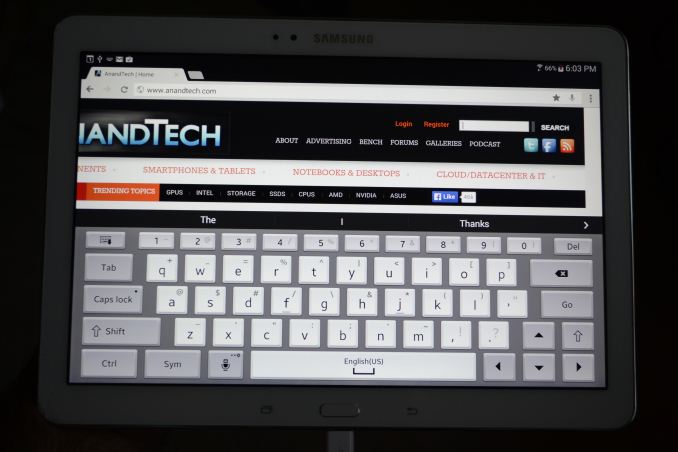
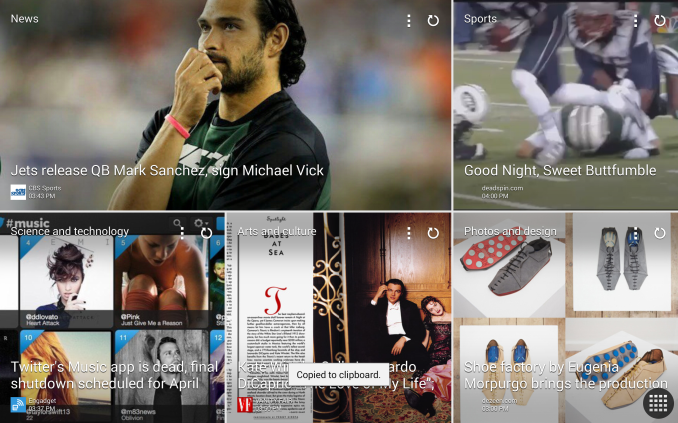
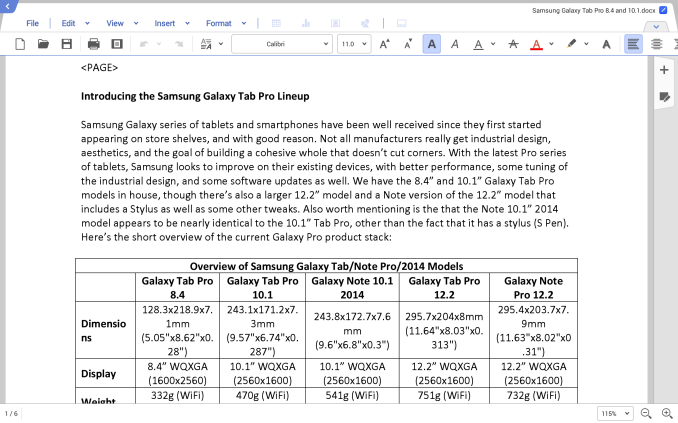
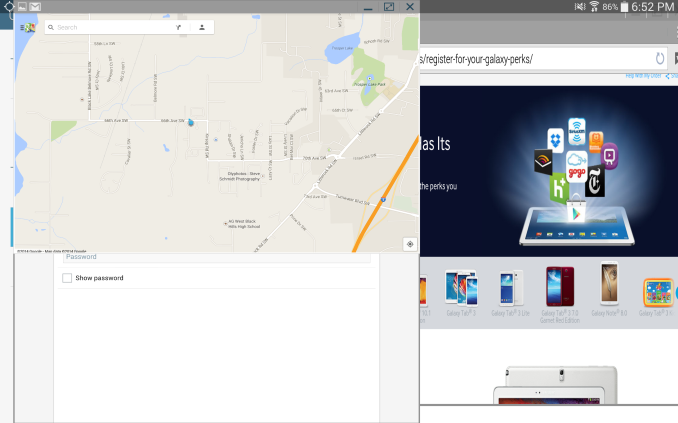
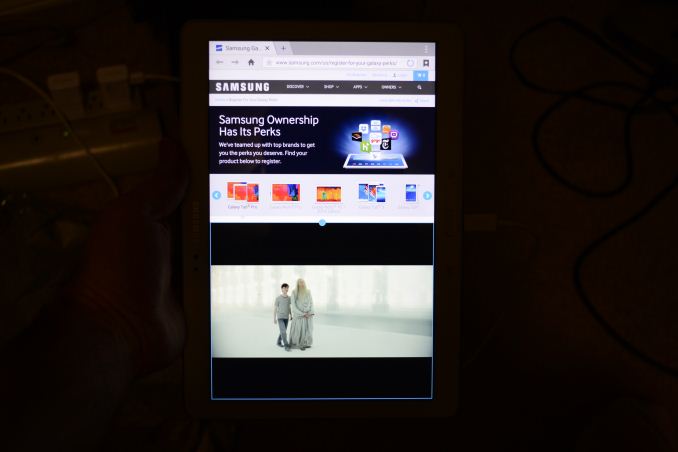
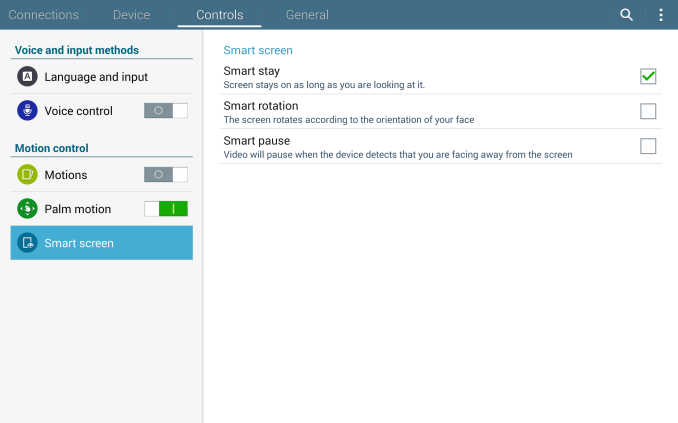
_thumb.png)
_thumb.png)
_thumb.png)
_thumb.png)
_thumb.png)
_thumb.png)








125 Comments
View All Comments
Wilco1 - Monday, March 24, 2014 - link
What is claimed this is CPU performance at maximum frequency, not a latency test of bursty workloads. It would be interesting to see Anand's browsing test reporting both power and performance/latency results as it seems a reasonable test of actual use. However SunSpider is not like a real mobile workload.The datasets for most of the benchmarks in Geekbench are actually quite large, into 20-30MBytes range. That certainly does not fit into the L2 on any SoC I know, let alone on L1. So I suggest that Geekbench gives a far better idea of mobile performance than a benchmark that only measures the set of JIT optimization tricks to get a good SunSpider score.
Intel doesn't have magic that makes frequency scaling 10-100 times faster - PLLs and voltage regulators all use the same physics (until recently Intel was using the same industry-standard voltage regulators as everybody else). The issue is one of software, the default governor is not recognizing repeated patterns of bursty behaviour and keeping clocks high for longer when necessary. Intel avoids the Linux governor issues by using a separate microcontroller. I have no doubt that it has been well tuned to the kind of bursty behaviour that SunSpider exhibits.
virtual void - Monday, March 24, 2014 - link
So you are suggesting that the performance counters in Sandy Bridge is reporting the wrong thing when it reports 97% L1D$-hit rate in Geekbench? They seem to work quite well on "real" programs.The performance counters also suggest that Geekbench contains trivial to predict branches, while program developed with dynamic languages and/or OOP languages usually contains a lot of indirect and even conditional indirect calls that is quite hard to predict. Only the most advanced CPU-designs keep history on conditional indirect calls, so a varying branch target on a indirect call will always result in a branch-prediction miss on mobile CPUs.
The sampling frequency of CPU-load and the aggressiveness the Linux kernel switches P-state is based on the reported P-state switch latency. All modern Intel CPUs report a switching latency of 10µs while I haven't seem any ARM SoC report anything lower than 0.1ms. The _real_ effect of this is that Intel platforms will react about ten times as fast to a sudden burst in CPU-load when running Linux-kernel.
Wilco1 - Monday, March 24, 2014 - link
SPEC2006 has ~96% average L1D hit rate, so do you also claim SPEC has a small working set and runs almost entirely out of L1? The issue is not about the correctness of the performance counters but your interpretation of them. The fact that modern CPUs can run at multiple GHz despite DRAM internally running at ~50MHz still is precisely because caches and branch predictors work pretty well.C++ and GUI code typically only has a limited number of distinct targets, which are easy to predict on modern mobile CPUs (pretty much any ARM CPU since Cortex-A8 has had indirect predictors, and since A15 they support multiple targets). I've never seen conditional indirect calls being emitted by compilers, so I can imagine some CPUs may ignore this case, but it's not in any way hard to predict. The conditional indirect branches you do get in real code are conditional return (trivial to predict) and switch statements on some ARM compilers.
Well if there is such a large difference then there must be a bug - I did once glance over the Samsung cpufreq drivers and they seemed quite a mess. It is essential to sample activity at a high resolution, if you sample at Nx slower rate then you do indeed react N times slower to a burst of activity - irrespectively of how fast the actual frequency/voltage scaling is done.
Egg - Monday, March 24, 2014 - link
Alright, I'll admit I didn't actually read the article. It just seemed you were unaware of what Brian had said previously.UltraWide - Saturday, March 22, 2014 - link
The Galaxy Note 10.1 2014 has 3GB of RAM.JarredWalton - Sunday, March 23, 2014 - link
It's not clear if all 10.1 Note 2014 come with 3GB, or just the 32GB models, but I'm going to go with 3GB (and hopefully that's correct, considering the cost increase for the Note). I had the Samsung specs pages open when putting together that table, and unfortunately they didn't list RAM on the 10.1 16GB I was looking at. Weird.Reflex - Saturday, March 22, 2014 - link
" If you want another option, the Kindle Fire HDX 7” ($200) and Kindle Fire HDX 8.9” ($379) pack similar performance with their Snapdragon 800 SoCs, but the lack of Google Play Services is a pretty massive drawback in my book."For many of us that's actually the Kindle line's largest advantage. Android and a good chunk of its app ecosystem, without compromising our privacy and exposing ourselves to all the malware. Plus we got these specs six months ago with the HDX line, and for a lower price in a better package.
A5 - Saturday, March 22, 2014 - link
Yeah, because the best way to avoid malware is to bypass the Play Store and install an APK from a random website to get Youtube to work.And you're only fooling yourself if you think Amazon is any better for your privacy than Google.
Reflex - Saturday, March 22, 2014 - link
Have you actually read their privacy policies and compared? Or taken a look at their profit models? There is a significant difference between the two for their approaches to privacy.And no, if I really care to get an app like that I can get it from a third party market if I must. There are some that mirror the Play store. But that said, there are very few needs that are not met via apps already available in the Amazon store.
R0H1T - Sunday, March 23, 2014 - link
So you're saying that Amazon has no record of you in their database whatsoever OR that they don't track your browsing history through their Silk browser, using Amazon's own servers, & never target (ads/promos) you based on your buying/browsing history ?I'd say you're deluding yourself if you think that Yahoo, twitter, FB, bing or even Amazon are any different than Google when it comes to tracking their users or targeting them with specific ads/promos based on their (recorded) history ):